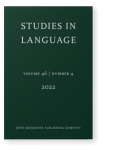Possessive inflection in Chichimec inalienable nouns
The morphological organization of a closed irregular class
Person and number of a possessor are expressed in Chichimec in one of two ways. Most nouns use possessive classifiers. A smaller class (typically inalienables) inflects for the possessor synthetically. This paper constitutes the first in-depth exploration of this latter class. These nouns are characterized by unparalleled levels of irregularity, with more than 100 different inflection classes and most nouns exhibiting completely unique exponence patterns. The morphology of these nouns is based on several orthogonal inflectional layers: prefixes, stem alternations, and tone, all of which exhibit only weak predictive relations to other subsystems or cells, and equally unpredictable mappings to the possessor values they instantiate. The system is also extremely challenging with respect to segmentation, as most of the segments within the word can change in inflection seemingly independently of the neighbouring ones. This paper surveys this baroque system in search of its organizational principles.
Article outline
- 1.Introduction
- 2.Nominal (possessive) inflection in Chichimec
- 3.The inflectional complexity of “inalienable” nouns
- 3.1Person-number prefixes
- 3.2Stem alternations
- 3.3Inflectional tone
- 4.Discussion
- 5.Segmentation, speaker knowledge, and the PCFP
- 6.Conclusion
- Acknowledgements
- Notes
- Abbreviations
-
References
References (33)
Ackerman, Farrell, Blevins, James P. & Malouf, Robert
2009 Parts and wholes: Implicative patterns in inflectional paradigms. In
James P. Blevins &
Juliette Blevins (eds.),
Analogy in grammar: Form and acquisition, 54–82. Oxford: Oxford University Press.


Ackerman, Farrell, Robert Malouf & James P. Blevins
2016 Patterns and discriminability in language analysis.
Word structure 9(2). 132–155.


Avelino, Heriberto & Eurie Shin
2011 Chapter 1: The phonetics of laringealization in Yucatec Maya. In
Heriberto Avelino (ed.),
New perspectives in Mayan linguistics, 1–20. Cambridge: Cambridge Scholars Publishing.

Baerman, Matthew
2011 Defectiveness and homophony avoidance.
Journal of Linguistics 47(1). 1–29.


Baerman, Matthew
2014 Suppletive kin term paradigms in the languages of New Guinea.
Linguistic Typology 18(3). 413–448.


Bank, Sebastian
2017 Segmentation: A remark on the Syncretism Principle.
Morphology 27(1). 1–20.


Beniamine, Sacha & Matías Guzmán Naranjo
2021 Multiple alignments of inflectional paradigms.
Proceedings of the Society for Computation in Linguistics 4(1). 216–227.

Boyé, Gilles and Gauvain Schalchli
2019 Realistic data and paradigms: The paradigm cell finding problem.
Morphology 29(2). 199–248.


Carroll, Matthew Jay
2016 The Ngkolmpu Language with special reference to distributed exponence. Canberra: Australian National University PhD dissertation.
Dahl, Östen & Koptjevskaja-Tamm, Maria
2001 Kinship in grammar. In
Irène Baron,
Michael Herslund &
Finn Sørensen (eds.),
Dimensions of possession, 201–225. Amsterdam: John Benjamins.


De Angulo, Jaime
1933 The Chichimeco language (Central Mexico).
International Journal of American Linguistics 7(3/4). 152–194.


Erdmann, Alexander, Micha Elsner, Shijie Wu, Ryan Cotterell & Nizar Habash
2020 The paradigm discovery problem. In
Proceedings of the 58th Annual Meeting of the Association for Computational Linguistics, 7778–7790, Online. Association for Computational Linguistics.


Feist, Timothy & Enrique L. Palancar
2015 Oto-Manguean Inflectional Class Database. University of Surrey.
[URL]
Feist, Timothy & Enrique L. Palancar
2021 Paradigmatic restructuring and the diachrony of stem alternations in Chichimec.
Language 97(1). 1–41.


Ferro, Marcello, Claudia Marzi & Vito Pirrelli
2011 A self-organizing model of word storage and processing: implications for morphology learning.
Lingue e linguaggio 10(2). 209–226.

Gibson, Lorna & Doris Bartholomew
1979 Pame noun inflection.
International Journal of American Linguistics 45(4). 309–322.


Herce, Borja
2020 Stem alternations in Kiranti and their implications for the morphology–phonology interface.
Journal of Linguistics 57(2). 321–363.


Herce, Borja
2022 Stress and stem allomorphy in the Romance perfectum: emergence, typology, and motivations of a symbiotic relation.
Linguistics.


Lastra, Yolanda
2004 Caracterización del chichimeco jonaz: la posesión.
Revista de Lenguas Indígenas y Universos Culturales Año 2004(1). 61–80.

Lee, Jackson & John A. Goldsmith
2014 Automatic morphological alignment and clustering.
Technical report TR-2014-07, Department of Computer Science, University of Chicago.

Lizárraga Navarro, Glenda Zoé
2018 Morfología verbal de persona y número en Chichimeco jonaz. Tlalpan: El Colegio de México PhD dissertation.
Mansfield, John, Sabine Stoll & Balthasar Bickel
2020 Category clustering: A probabilistic bias in the morphology of verbal agreement marking.
Language 96(2). 255–293.


Mansfield, John
2016 Intersecting formatives and inflectional predictability: How do speakers and learners predict the correct form of Murrinhpatha verbs? Word Structure 9(2). 183–214.


Marmion, Douglas Edric
2010 Topics in the phonology and morphology of Wutung. Canberra: Australian National University PhD dissertation.
Nevins, Andrew
2011 Multiple agree with clitics: Person complementarity vs. omnivorous number.
Natural Language & Linguistic Theory 29(4). 939–971.


Nordlinger, Rachel
2015 Inflection in Murrinh-Patha. In
Matthew Baerman (ed.),
The Oxford handbook of inflection, 491–520. Oxford: Oxford University Press.

Palancar, Enrique L. & Heriberto Avelino
2019 Inflectional complexity and verb classes in Chichimec.
Amerindia 411. 323–360.

Parker, Jeff & Andrea D. Sims
2019 Irregularity, paradigmatic layers, and the complexity of inflection class systems: A study of Russian nouns. In
Peter Arkadiev &
Francesco Gardani (eds.),
The complexities of morphology, 23–51. Oxford: Oxford University Press.

Silvey, Catriona, Simon Kirby & Kenny Smith
2015 Word meanings evolve to selectively preserve distinctions on salient dimensions.
Cognitive Science 39(1). 212–226.


Spencer, Andrew
2012 Identifying stems.
Word Structure 5(1). 88–108.


Stump, Gregory & Raphael A. Finkel
2015 The complexity of inflectional systems.
Linguistics Vanguard 1(1). 101–117.


Thornton, Anna M.
2012 Reduction and maintenance of overabundance. A case study on Italian verb paradigms.
Word Structure 5(2). 183–207.


Cited by (1)
Cited by 1 other publications
Herce, Borja
2024.
VeLePa: Central Pame verbal inflection in a quantitative perspective.
Morphology 
This list is based on CrossRef data as of 5 july 2024. Please note that it may not be complete. Sources presented here have been supplied by the respective publishers.
Any errors therein should be reported to them.
